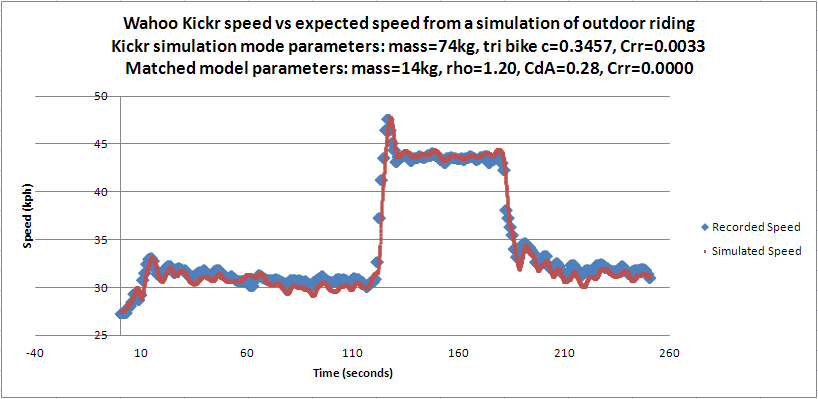wcb wrote:
Thanks for the feedback as I navigate new waters. I've been doing a bit of digging regarding the topic. The British time trialists seem to take how the bike on trainer reacts to pedaling way more seriously than the average Slowtwitcher. The whole thread is an interesting read but here's a single interesting post. This post is regarding riding in slope mode but I think you can still apply it to think about erg mode.
http://www.timetriallingforum.co.uk/...php?showtopic=103637 Posted 26 October 2015 - 01:14 PM
Clayton has generously provided me with a file from the Wahoo Kickr to analyse. This is the result:

Again, it doesn't match the simulation parameters that he specified. For example, he specified a mass of 74kg, but it has only provided an inertial effect equivalent to that of a 14kg mass. There is also something a little odd going on in terms of Crr, with the best fit occurring with a Crr of zero. Even then, there is no perfect overall fit between the model and the actual speed data. Matching the speed at ~300W leaves it a little low at ~100W. The only way to resolve this is to reduce Crr, but even with Crr=0, it doesn't quite match. I can make it match by taking Crr negative. Crr -0.015 and CdA 0.308 makes the speed match at both powers, but a negative Crr is kind of silly.
I think this strange effect is probably down to the Kickr fundamentally just being a magnetic trainer with some automatic control of resistance, so it doesn't naturally have a power curve that matches outdoors like a wind or fluid trainer does.
My feeling is that the inertial effect is most likely just that which is provided naturally by the geared flywheel, and there is most likely no high frequency adjustment of resistance within the pedal stroke to simulate inertia."
Here's a post from JV Coaching Alpha Company that addresses the Kickr in erg mode.
" KICKR Training Notes:
Often a discrepancy can be found between the power values of the KICKR and your power meter. This is attributed to the differences in inertia of a cyclist on the road, versus the inertia of the KICKR's flywheel. Cycling on the road is a high inertia environment, demonstrated by the degree to which the cyclist can coast when not pedalling, versus the rapid decline in speed of a fluid or magnetic wind trainer when pedalling stops. Due to the KICKR's heavy flywheel, it carries a lot more inertia, which allows it to have the 'road-like' feel that is appealing to cyclists. But,
depending on the speed of the flywheel, it's inertia changes markedly. Considering the ERG mode of the KICKR is generally the most used programme for a cyclist when undertaking strength work, use of the small chain ring will generate a lower level of inertia requiring the muscles to work more consistently throughout the entire pedal stroke, especially through the 10 o'clock to 2 o'clock position where muscle strength is lowest. Often an 8-10% difference in wattage can be seen between the KICKR's power output and that of the cyclist's power meter due to this difference in inertia, and also that the cyclist's power is being read at different points in the drive chain (i.e. crank arm vs. spider vs. rear hub/KICKR).
Use of the large chain ring results in the KICKR flywheel having a higher rotational inertia, more in line with that of the cyclist riding on the road. In this situation we usually see the difference in power readings much smaller or the same."
Hugh
Genetics load the gun, lifestyle pulls the trigger.
